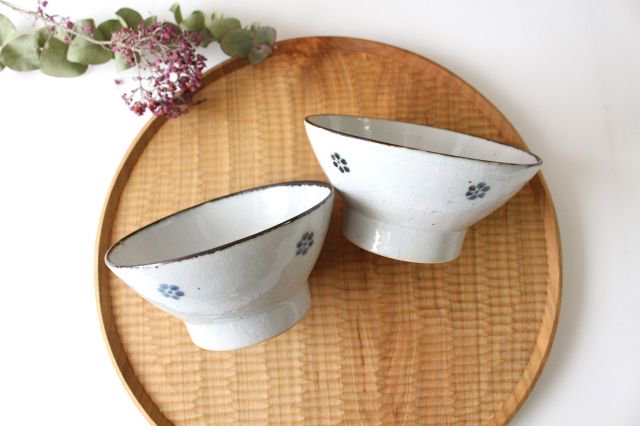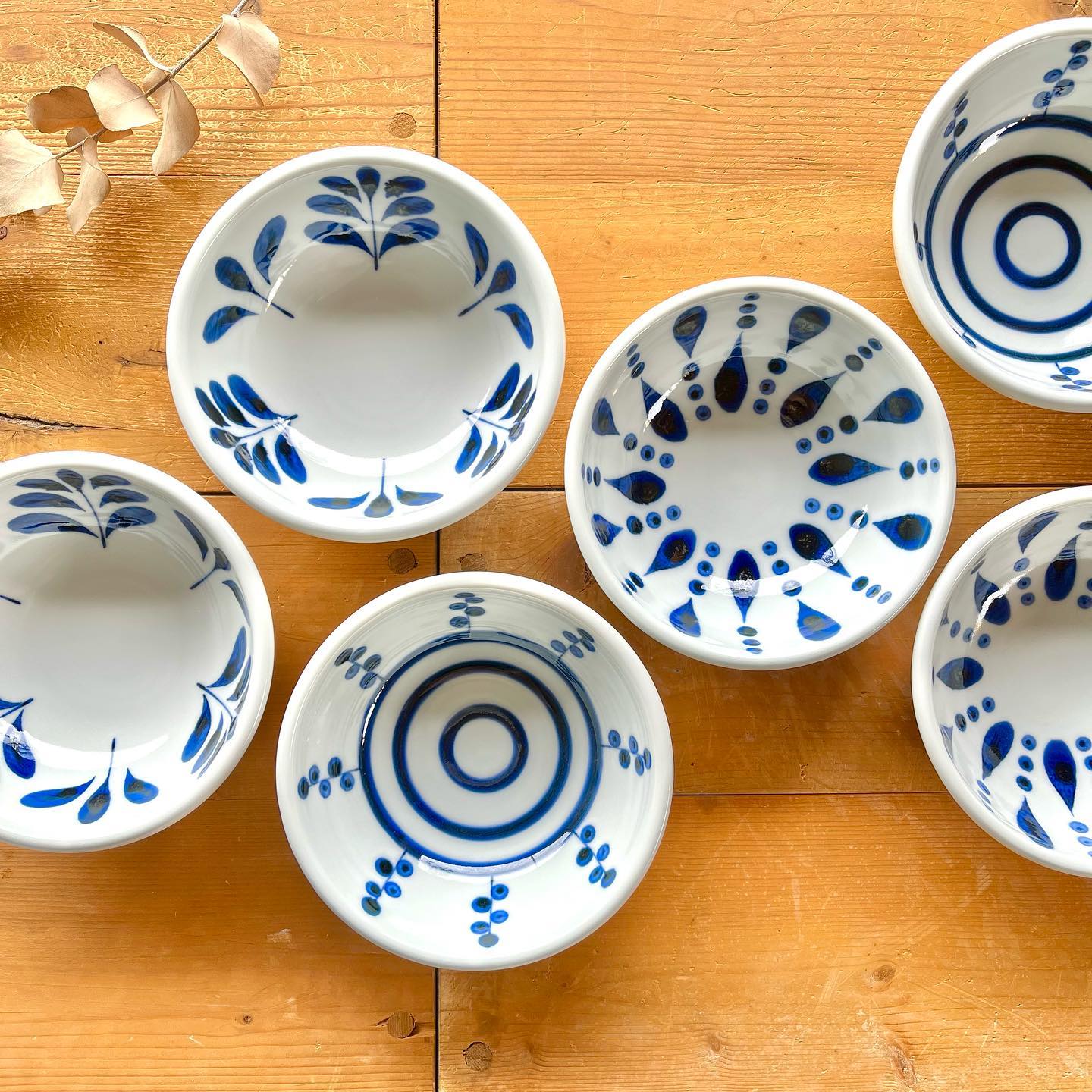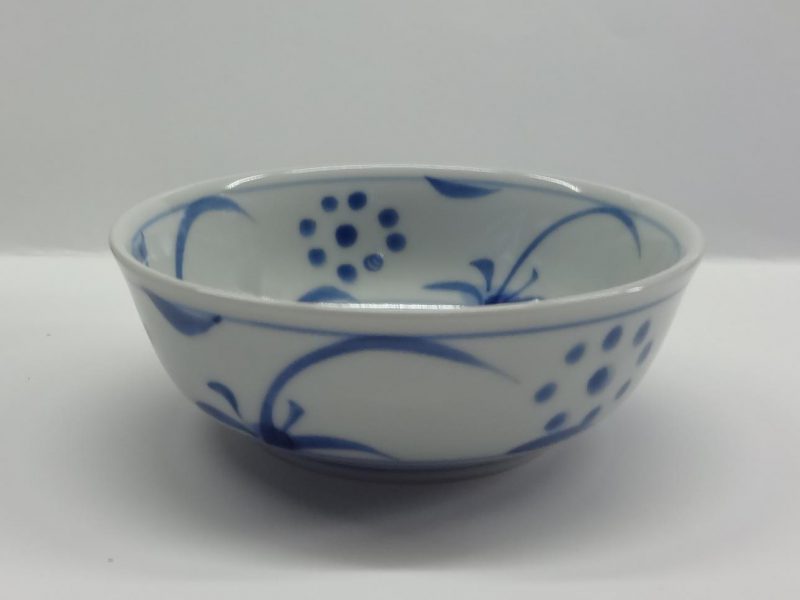Hello, this is Taki from the UTSUWABI Pottery City Editorial Department.
"Tobeyaki(Tobe ware)" is a type of porcelain made mainly in Tobe Town, Iyo District, Ehime Prefecture.
While four types of pottery, white porcelain, dyed porcelain, celadon porcelain, and tenmoku (iron glaze), are designated as traditional crafts of the country, there are many types of pottery that are highly practical and designed, and are perfect for daily life. is also one of its charms.
This time, we will introduce the charm of "Tobe ware" and Tobe ware utensils.

What is Tobe ware?
Characteristics of Tobe ware
Tobe ware is a type of ceramic that is produced mainly in Tobe Town, Ehime Prefecture, which is said to be the best pottery village in Shikoku.
The characteristics of Tobe ware are its slightly thick and plump form, and the indigo dyeing on the white porcelain.
Compared to other types of porcelain, it is difficult to crack or chip and is durable, so it is loved as a porcelain that can be used on a daily basis.

One of the characteristics of Tobe ware is that it preserves the tradition of handmade and hand-painted items.
Although it is not a large production area nationwide, Tobe ware is highly praised by many pottery lovers for its simple texture and plump and adorable form.
History of Tobe ware
It is said that its beginnings date back to around 1700 during the Edo period.
It was developed by the Daishu clan because they could obtain the raw materials for porcelain.
During the recession from the end of the Taisho period to the beginning of the Showa period, production declined, but it recovered with the help of a folk craft boom.
It also received high praise from Soetsu Yanagi and others who promote the folk art movement.
It has been designated as a national traditional craft, and currently around 100 potteries continue to create unique pieces while preserving tradition.
Introduction of popular pottery
Porcelain Kiln Nagato Ceramic Works

Tosaigama Nagato Seisho is a pottery run by a father and son.
Tetsuya Nagato, whose style focuses on blue-and-white porcelain, Junko Nagato, who proposes new Tobe ware, and Yumu Nagato, who creates with free ideas while valuing traditional techniques, make three types of pottery. Three people.
Although the styles of all three of them are different, each pottery is created with the idea of "a pottery that blends in with daily life and allows us to spend our daily lives with care and care."
Old Tobe rice bowl, small, Koume pattern, semi-porcelain, pottery kiln, Tobe ware

This is a rice bowl with an indigo blue plum pattern that makes you feel at ease.
The form has a solid height and is easy to pick up.
The simple and classic design will never get old and you can use it for a long time.
Old Tobe 5 inch deep plate, Hanagaki pattern, semi-porcelain, ceramic kiln, Tobe ware

A plate that uses a typical technique of Tobe ware, which is based on the pattern of old Tobe ware from the Edo period called Kotobe pattern.
Dishes are characterized by the "kanyu" cracks that occur when they are cooled after firing, and the more you use them, the more you can enjoy their changes.
Mori Pottery

Mori Pottery, which opened its kiln in 1970, has been making pottery for three generations while preserving tradition.
With ease of use and fun, we value the "Mori Tobo-like tableware and worldview" and create pottery that makes meals enjoyable.
There is also an article in which the UTSUWABI Editorial Department visited Mori Tobo on a trip around pottery, so be sure to read it.
Journey Through Utensils Vol. 2: The Timeless Appeal of Tobe Ware
Mug Konoha semi-porcelain Mori Tobo Tobe ware

A mug with a pattern that makes you feel the story, as if you were looking at a picture book.
This semi-porcelain is the best of both worlds: warm earthenware and dignified porcelain.
7-inch plate ballerina porcelain Mori Tobo Tobe ware

The "KAORI" series by Kaori of Mori Tobo is a series of vessels that will make your heart flutter.
You'll fall in love with this pottery at first sight due to its cute ballerina pattern and traditional indigo color typical of Tobe ware, and you'll have fun just thinking about what food to pair it with.
Satsuki Kiln

Satsuki Kiln is a kiln opened in 2017 by Taro Nakata, the son of the aforementioned Nakata Kiln, and his wife Chiharu.
Taro's style is traditional yet modern, while Chiharu's is delicate and cute.The two artists have different styles. Although these two pieces have different personalities, when you put them together, you can feel the harmony between them, which makes them very attractive.
The origin of Satsuki Kiln is that the kiln was started in May (Satsuki). The "5" mark on the bottom is also popular for being cute.

Rice bowl, flying butterfly, porcelain, Satsuki kiln, Tobe ware

A rice bowl with a cute butterfly on it that would be fun to display on the dining table. The indigo color typical of Tobe ware is vivid and eye-catching.
Since it is deep enough, you can fill it with more rice than it looks.
Square rim plate, medium itch dot, porcelain, Satsuki kiln, Tobe ware

This square plate uses a technique called "Itchin" to draw patterns with "mud", giving it a three-dimensional feel when you touch it.
White porcelain with a slight bluish tinge will look great on any dish, making it perfect for everyday use as well as entertaining.
Sukoshiya

While valuing the tradition of handcrafted Tobe ware, Sukoshiya creates products that are a little more beautiful, a little more fun, and a little more challenging than what we do today.
The utensils, which are made with cute and gentle patterns on a milky-white matte textured ground, have won numerous awards, including the Tobe Ware New Works Exhibition Grand Prize.
Flat bowl, Aohana, porcelain, Sukoshiya, Tobe ware

This pottery has a calming color that makes you feel warm, and you can feel the warmth that can only be achieved by handicrafts.
It is a slightly deep container, and is the perfect size for serving dishes for one or two people, such as meat and potatoes or Chikuzenni.
Soba choko gourd porcelain Sukoshiya Tobe ware

A soba choko with a boldly drawn gourd.
The right thickness fits your hand.
Not only can you use it as a soba choko, but you can also use it all year round to make cold drinks on hot days and hot drinks when it gets cold.
Unseki kiln

Kumoseki Kiln is a historic kiln that opened in 1919.
Many of the patterns drawn in an original blend of deep indigo have simple yet impactful compositions, giving a sense of tradition but with a modern feel.
Unsekigama's utensils, which go well with any kind of cuisine, are often ordered by restaurants.
Handmade small plate, walnut, porcelain, cloud stone kiln, Tobe ware

As the name "handmade small plate" suggests, it is an attractive tableware with flexible lines that are unique to handmade products.
The thickness and weight typical of Tobe ware are proof of its durability.
It's the perfect size for a side dish.
It's perfect for ice cream and other desserts, so it's likely to become an indispensable part of your daily dining table.
Nakata kiln

Nakatagama pottery is made by mixing white porcelain with rough clay and firing it, giving it a somewhat rustic and tasteful appearance.
Utensils made with the concept of "pottery that combines utility and beauty to enrich and enjoy life" have a reputation for being versatile and can be used without making too much of a statement on the dining table.
Soba choko (small) Gosu lily of the valley Porcelain Tobe ware Nakata kiln

This soba choko is made of white porcelain with indigo dyeing and has a simple and tasteful taste typical of Nakatagama.
It's just the right size to fit in one hand, and can be used in a variety of situations, such as small bowls, teacups, and sake vessels.
Although the pattern is unique, the colors are simple, so it blends easily with your dining table.
6-inch pot, Gosuha Tokusa, porcelain, Tobe ware, Nakata kiln

The pottery is plump and has a thick handmade texture.
The hajukusa pattern drawn in indigo will complement your dishes.
The easy-to-use 6-inch size makes it appear on the dining table a lot.
It has just the right amount of depth, so it can also be used for rice bowls and noodles.
Tobo Yu
 Quote: Yu Toubou Official Instagram
Quote: Yu Toubou Official Instagram
This is a pottery in Ehime Prefecture where Mr. and Mrs. Keiji Matsuda and Mr. and Mrs. Naoriko make pottery.
As a means of making pottery for everyday use, we create pottery necessary for everyday dining, such as rice bowls, plates, small plates, small bowls, and tea cups, using techniques that are not limited by genre.
4.5 size beaded pot
 Quote: Yu Toubou Official Instagram
Quote: Yu Toubou Official Instagram
A medium bowl with a plump edge that gives a warm impression.
It looks like it would be perfect for serving juicy side dishes such as dipping sauce.
The dyed pattern that can be seen between the dishes is an accent that will make your dishes stand out.
Colored pattern
 Quote: Yu Toubou Official Instagram
Quote: Yu Toubou Official Instagram
A plate with a gorgeous atmosphere, decorated with red and gold overlays.
Combined with traditional Japanese patterns, it will also be an accent to your dining table.
Baizangama
 Quote: Baizangama official Instagram
Quote: Baizangama official Instagram
Umeyama kiln is a kiln that was opened in 1898 and is the oldest kiln in Tobe ware.
Baizangama's original patterns, such as arabesques, are drawn using a unique technique called "freshly applied one stroke."
The plump and thick pottery is perfect for everyday use, and we have a wide selection of Tobe ware that is typical of Tobe ware.
6-inch beaded pot outside arabesque
 Quote: Baizangama official website
Quote: Baizangama official website
This is a pot with a thick beaded edge.
It has arabesque painting, which is a typical pattern of Baizan kiln, and can be said to be typical of Tobe ware.
The gentle white and indigo colors never get boring and complement your dishes, so you'll want to use them every day.
3.7-inch pot inside and outside sun
 Quote: Baizangama official website
Quote: Baizangama official website
Due to its depth, it can be used as a serving plate for hotpots and other juicy dishes.
The pattern is typical of Tobe ware, but it is unusually thin for Tobe ware, which is often made with thick vessels.
It is a relatively lightweight and easy-to-use container.
Tobe ware table coordination
 Quote: Mori Tobo Official Instagram
Quote: Mori Tobo Official Instagram
Tobeyaki rice bowls go well with standard Japanese dishes.
The blue pattern brings out the yellow color of the tamago, and just looking at it makes my stomach growl.
 Quote: Satsukigama official Instagram
Quote: Satsukigama official Instagram
The cool blue color enhances the freshness of the watermelon.
Thanks to the rim, the fruit juice won't spill out when cleaning up, which is nice.
 Quote: sorsnd_camp(Instagram)
Quote: sorsnd_camp(Instagram)
Assort the side dishes.
The dot pattern lined up on the rim enhances your food just like a picture frame.
The colors and decorations are not too overpowering, so they are easy to match with other pottery.
Sightseeing in Tobe
If you want Tobe ware, why not actually visit Tobe?
If you shop around at local stores, you're sure to find something you like.
We will introduce recommended shops and sightseeing spots when visiting Tobe.
Access to Tobe Town
It can be accessed from Matsuyama in about an hour by public transportation, or about 30 minutes by car, depending on traffic conditions.
From Matsuyama Airport: Limousine bus (about 25 minutes) → Matsuyama City Station → Iyotetsu Bus Tobe Line (about 40 minutes) → Tobe Town
From Matsuyama Station: City train (about 7 minutes) → Matsuyama City Station → Iyotetsu Bus Tobe Line (about 40 minutes) → Tobe Town From Matsuyama IC (by car): Take National Route 33 towards Tobe. 10 minutes to Tobe Town Hall, 15 minutes to Traditional Industry Hall.
Bus tickets are also available, so please check the Tobe Town website for details.
For more information about access Click here
Store/sightseeing spots you should visit when visiting Tobe
Gallery Shion
 Quote: Gallery Shion official Instagram
Quote: Gallery Shion official Instagram
This is a Tobe ware select shop located in Torigaoka, the hill of Tobe ware pottery, and mainly sells "everyday utensils."
Selecting your utensils in the store where you can feel the warmth of wood will give you a peaceful feeling.
There are so many artists and potteries that we deal with, so before you know it, the time will have passed in the blink of an eye.
Address: 885-13 Gohonmatsu, Tobe-cho, Iyo-gun, Ehime Prefecture
Business hours: 10:00-18:00
Closed: Closed/Tuesday: Third Wednesday
Telephone: 089-962-7674
Cafe & Gallery Moegino
 Quote: Cafe & Gallery Moegi's official Instagram
Quote: Cafe & Gallery Moegi's official Instagram
This is a cafe and gallery located in the mountains of Tobe that sells Tobe ware.
You can enjoy lunch and dessert in Tobe-yaki utensils, and you can see the Tobe River and the majestic mountains from the terrace seats.
You can enjoy Tobe ware both visually and with food.
Address: 495 Kawato, Tobe-cho, Iyo-gun, Ehime 791-2143
Business hours: 11:00- 17:00
Closed: Tuesdays, Wednesdays, year-end and New Year holidays
Telephone: 089-916-3157
Rural craft experience center
Using clay made from locally abundant pottery stone, you can hand-shape, mold using a potter's wheel, and paint in 15 colorful colors.
There is also a 100 meter roller slide, where you can play while enjoying the nature of the Hirota area.
Address : 117 Sotsu, Tobe-machi, Iyo-gun, Ehime Prefecture
Business hours: 9:00-17:00
Closed on Tuesdays (the following day in the case of holidays), December 30th - January 3rd of the following year
Phone: 089-969-5087
HP: https://www.town.tobe.ehime.jp/soshikikarasagasu/shoukoukannkouka/kankou/9/678.html
Tobeyaki Festival
The Tobeyaki Festival is held in spring (April) and autumn (November).
This is a popular pottery market where about 70 potteries sell face-to-face at the venue, and the number of visitors reaches as many as 100,000.
The items are sold at a slightly lower price than the list price, and in addition to the pottery market, there are many other activities such as potter's wheel and painting experiences, and live performances on stage.
Location : Tobe Town Tokaido Yutori Park
Hours: 9:00-16:00 (17:00 on the last day)
HP: https://www.town.tobe.ehime.jp/kankosaito/meguru_taikensuru/2402.html
Summary
Tobe ware is loved as a pottery for everyday use due to its simple texture and durability.
The patterns and colors drawn on the vessels are also very attractive.
Please see the link below for the Tobe ware that we handle at our store.
While preserving tradition, each pottery has its own unique characteristics, so why not find your favorite pottery? Once you pick one up, you'll be charmed by its ease of use and cuteness, and you'll want to buy a variety of them.
In addition to the Japanese tableware introduced above, we also sell a variety of other utensils, so please take a look.
Here is the link to the UTSUWABI website
Thank you for reading until the end. I hope you all find good works!
